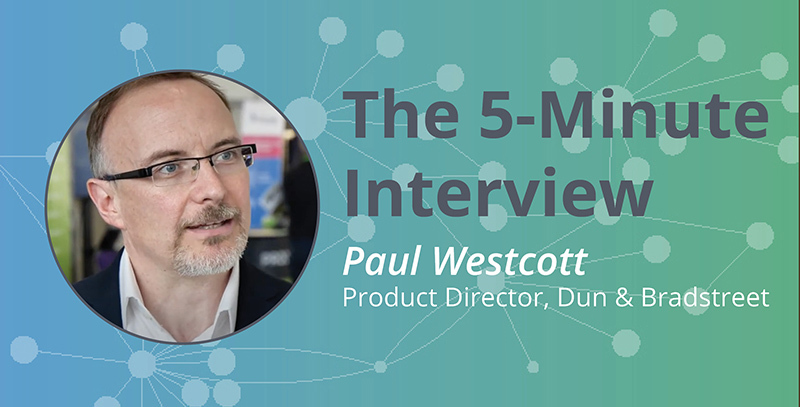The Lean-In Moment: 5-Minute Interview with Paul Westcott

Product Marketing Manager, Neo4j
4 min read

“GraphTour is something that allows us to think differently. We have one-to-one sessions and we’re able to collaborate, but it’s nice to come to something like this and see other people and how they’re using graph technology,” said Paul Westcott, Product Director at Dun & Bradstreet.
If company A owns company B and company B owns company C which in turn owns company A, that is a loop, and it is illegal. But in a dataset with 350 million companies, how do you find those patterns? By putting their massive dataset into the Neo4j graph database, Dun & Bradstreet empowers financial services customers to rapidly query the data and surface connections in less than a minute.
In this week’s five-minute interview (conducted at GraphTour NYC 2019), we speak with Paul Westcott about how Dun & Bradstreet uses Neo4j.
What does Dun & Bradstreet do?
Dun & Bradstreet has a big dataset: we collect information on about 350 million companies. We pour that into Neo4j to understand insights, particularly around ownership of companies and who owns each company and the networks that Neo4j identifies are then generated to our customers.
How was this problem solved before graphs?
As a product manager, I get to spend time with people who work in financial institutions. And literally, individuals were taking a screenshot, they were printing a screenshot, they were typing data into a spreadsheet, they were taking another screenshot, they were typing more data into a spreadsheet, they were taking another screenshot and they were following all of the links themselves.
Before Neo4j, they would then brute-force some kind of Excel spreadsheet to get a credit calculation. And then they gave that to a relationship manager who would be able then have all of the information. On a good day, they could do a company in about half an hour. With Neo4j, they were able to type in the company, ask the question, have a visualization of those networks and how those paths were created, print that off and send it in around 30 or 40 seconds.
What have been some of the most surprising results you’ve experienced working with graphs?
I think the most surprising thing for us was firstly, we really didn’t realize just how many things were connected to each other. There was an assumption, but we were able to follow things such as loops, where company A would own company B, and company B would own company C and company C would own company A. So you’d have these loops which are actually illegal and you can identify them.
We actually found a lot of areas where we could pinpoint data inconsistencies and have our data teams go and get more data in a very accurate way and then feed that data back in to get better results.
Can you tell us about the reactions your graphs results get?
I always call it the lean-in moment. Talk to users and then when you show them the visuals and the possibilities of the graph and the connections, you literally see them move forward toward the computer screen. And I think of all of the things that I’ve seen in my career as a product manager, that lean-in moment is always the one that’s the best.
What’s next for Dun & Bradstreet?
So, right now we’re very much focused on companies and connecting companies and the networks there. For us, what’s next is understanding people and how we can connect people with companies so we have a much more people-centric view rather than a company-centric one.
What do you like most about GraphTour?
Dun & Bradstreet has been working with Neo4j for some time now and GraphTour always allows us to think differently. We have our one-to-one sessions and we’re able to collaborate with Neo4j, but it’s nice to come to something like this and see other people and how they’re using graph technology. It’s also a chance to hear different views and different ways of thinking, which I think is fundamental to any business and how they resolve challenges.
What advice do you have for people who are getting started with graphs?
Jumping straight in is a really good idea. But I would also say, think about it in terms of a single problem or a single use case. Often people will say, “We can solve so many things.” But if you focus on one thing and solve one thing well, you’ll find that after that, you may be able to then solve other problems in a similar way. But don’t try and bite off more than you can chew.
Want to share about your Neo4j project in a future 5-Minute Interview? Drop us a line at content@neo4j.com








